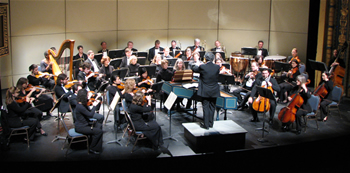Asheville audiences are not afraid of new music. The audience almost filled St. Mary’s Episcopal Church for an “All-American” program that included two works by contemporary composers. The acoustically fine space of this small church was made even more intimate when the Opal String Quartet set up their music stands in the nave rather than in the chancel. Being in the nave (the body of the church), the musicians were more directly in contact with the audience, which surrounded them. The Opal String Quartet has, over the years, had several changes in its violinists. The current violinists are Karen Pommerich and Mariya Potapova. The lower string players (Kara Poorbaugh, viola, and Franklin Keel, cello) are unchanged. This fine local chamber group, in cooperation with Pan Harmonia, performed the first half of the concert, and then was joined by flutist Kate Steinbeck after intermission for two quintets.
Ernest Bloch was a Swiss-born composer who adopted American citizenship in 1924 at age 44. His Prelude for String Quartet was a quiet work, and a good choice to open this concert. Written in 1925, it is characteristic of Bloch’s music, which often reflects Hebrew liturgical styles.
Next was the North Carolina premiere performance of Michael Hosford‘s Quartet No. 2 entitled “Time.” In his comments before the performance, the composer explained that the first of two movements represented timelessness and the second represented accuracy in time measurement. Even without the title or this description, the audience would have sensed the role of time in this interesting work. Hosford uses the resources of the string quartet well in the first movement, with a melody that migrates from instrument to instrument while the others perform minimalist motifs that underpin the solo work in a contrapuntal fashion. Several pizzicato passages break the music during the second half of the movement, emphasizing another element of “time” – the attack and duration of a single note. The second movement has a perpetuum mobile feeling. Cellist Keel was especially fine in both movements. The eight-minute composition deserves to be heard again, and a recording of its 2010 premiere can be found on the web at this link.
Dosia McKay is an artist with many facets. She writes poetry and short stories, paints, and composes music. Her 2013 string quartet work Is Now Not Enough? is based on one of her poems. She says, “I paint on a post-classical canvas with vibrant harmonies and expressive melodies.” The work performed at this concert was more devoted to establishing a “mood” than to realizing the rich resources of a string quartet, which is perhaps the most formidable chamber ensemble ever conceived. Other composers from Haydn through Bartók and beyond have sought depth by using the form. By contrast, this string quartet by McKay was shallow and disappointing. Dare I suggest that it is pretentious New Age music with no lasting substance? Twitter for the ears?
Following intermission came a delightful Theme and Variations, Op. 80 by Amy Beach (1867-1944) – America’s first female composer of note. The theme is unabashedly 19th century Romantic despite being written in 1916, and is stated by the strings alone. The first variation features the flute, and the remaining variations use all five instruments capably in various mixes. The theme is in 9/8 time, and the six variations cleverly move the thematic material into 2/4, 6/8 and 4/4 tempi before a recapitulation of the theme. That recapitulation, back in 9/8, now includes the flute. The performance by Steinbeck and the Opal Quartet was strong indeed.
The concert closed with “Impresiones de la Puna” by the Argentinian composer Alberto Ginastera, written for flute and string quartet. This impressionistic 1934 work does not have an opus number because Ginastera withdrew the work. I suspect he thought it somewhat trivial, but it is delightful when performed as well as it was by these fine musicians. Steinbeck shone on flute. It was a fitting choice to end the program.
Editor’s Note: Just to clarify, this program, heard also on Nov. 11 in Black Mountain, was a presentation of Pan Harmonia, given under the ensemble’s “Alternate Currents” banner. The concerts recevied support from the NC Arts Council.











